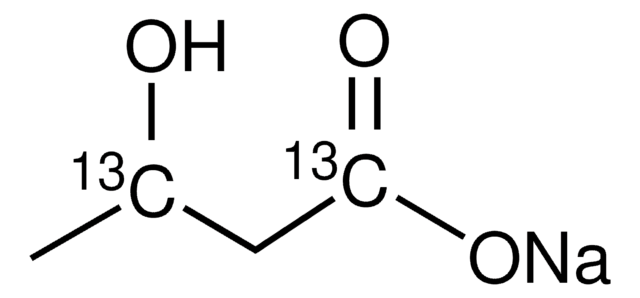This product is a neat or pure liquid and has not been diluted. The density of this material is 1.126 g/mL at 25 °C with a molecular weight of 104.1 daltons. The minimum purity of this product is 95%. The molarity of this product may range from 10.26 M at 95% to 10.8 M at 100%. Please refer to product Certificate of Analysis for the lot specific purity.
166898
3-Hydroxybutyric acid
95%
Synonym(s):
(±)-3-Hydroxybutanoic acid, DL-β-Hydroxybutyric acid
About This Item
Recommended Products
Quality Level
Assay
95%
form
liquid
refractive index
n20/D 1.443 (lit.)
bp
118-120 °C/2 mmHg (lit.)
solubility
ethanol: soluble 50 mg/mL, clear
density
1.126 g/mL at 25 °C
1.126 g/mL at 25 °C (lit.)
functional group
carboxylic acid
hydroxyl
storage temp.
2-8°C
SMILES string
CC(O)CC(O)=O
CC(O)CC(O)=O
InChI
1S/C4H8O3/c1-3(5)2-4(6)7/h3,5H,2H2,1H3,(H,6,7)
InChI key
WHBMMWSBFZVSSR-UHFFFAOYSA-N
WHBMMWSBFZVSSR-UHFFFAOYSA-N
Looking for similar products? Visit Product Comparison Guide
General description
Application
Signal Word
Danger
Hazard Statements
Precautionary Statements
Hazard Classifications
Eye Dam. 1 - Skin Corr. 1B
Storage Class Code
8A - Combustible corrosive hazardous materials
WGK
WGK 3
Flash Point(F)
233.6 °F - closed cup
Flash Point(C)
112 °C - closed cup
Personal Protective Equipment
Choose from one of the most recent versions:
Already Own This Product?
Find documentation for the products that you have recently purchased in the Document Library.
Customers Also Viewed
Chromatograms
suitable for GC-
3-ヒドロキシ酪酸は液体とのことですが,濃度はどれくらいになるのでしょうか?
1 answer-
Helpful?
-
-
What's the solubility in paraffin oil?
1 answer-
Unfortunately, solubility information for Product 166898 in paraffin oil is unavailable. However, it is soluble in ethanol at 50 mg/mL.
Helpful?
-
Active Filters
Our team of scientists has experience in all areas of research including Life Science, Material Science, Chemical Synthesis, Chromatography, Analytical and many others.
Contact Technical Service










![Poly[(R)-3-hydroxybutyric acid] natural origin](/deepweb/assets/sigmaaldrich/product/structures/129/476/7d1c924b-f644-4889-a2d6-d7a923ce382c/640/7d1c924b-f644-4889-a2d6-d7a923ce382c.png)


